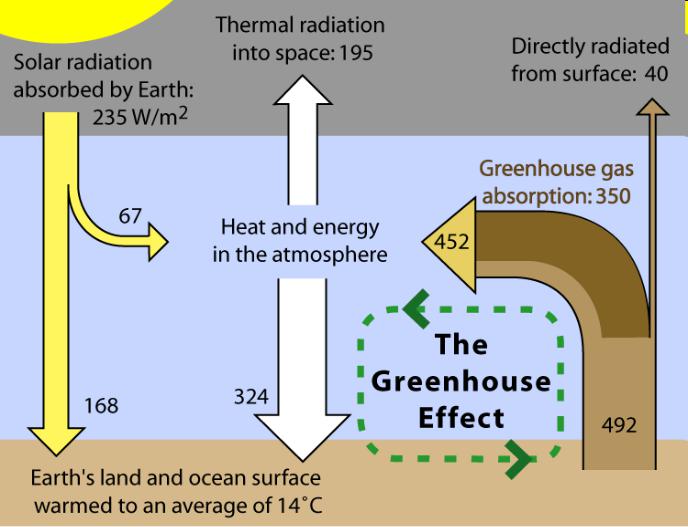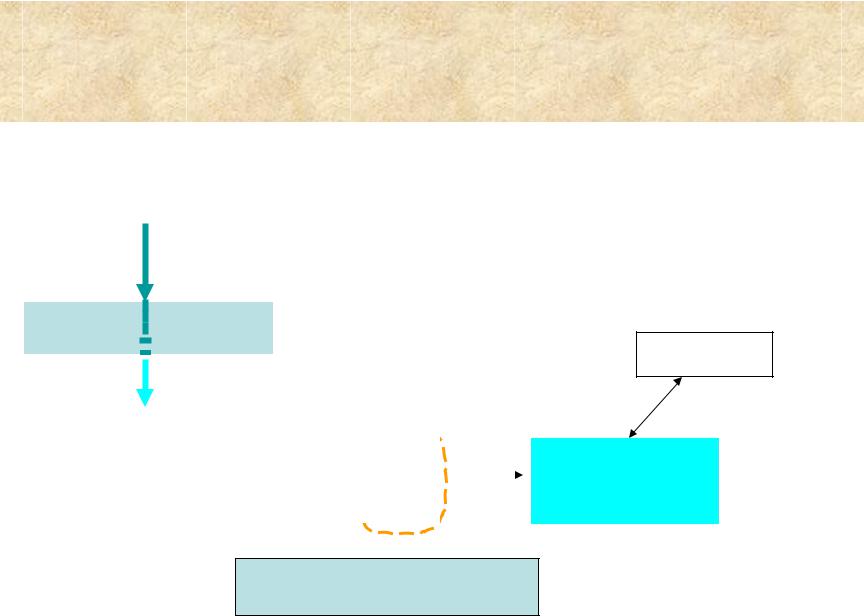
- •Solar Radiation
- •Energy exchanges are derived from Kiehl & Trenberth (1997).
- •Energetic state of a body
- •Units and notions
- •Wave nature of the radiant flux
- •dФds F F d
- •Absorption, reflection, transmission
- •Special properties of bodies
- •Transmission function for the atmosphere
- •Kirchhoff’s law
- •Gustav Robert Kirchhoff
- •Max Planck
- •1-st Wien’s law (Displacement law)
- •Practical application of the 1 Wien’s law?
- ••Much of a person's energy is radiated away in the form of infrared
- •Temperatures of flames by appearance
- •Some interesting results gained from the 1-st Wien’s law
- •The total flux and 2-nd Wien’s law
- •Grey body
- •Extinction and Bouguer’s law
- •Sum up of the radiation laws
- •Radiant energy brightness
- •Brightness - emittance relation in isotropic field of radiation
- •Definitions
- •Altitude (or Elevation)

Solar Radiation
The energy emitted by the Sun is called
SOLAR RADIATION.
It is the only source of energy for the Earth. Other sources: Earth’s surface – 5000 times less, Stars – 30.000.000 times less.
When arriving to Earth, the larger part of the solar radiation (SR) transforms to heat energy, and a small portion of it to electric energy (upper atmosphere).
30 30 900km2 area receives annually |
3,8 1015 kJ of energy |
1

Energy exchanges are derived from Kiehl & Trenberth (1997).
2

Energetic state of a body
Any body the temperature of which is above 0 K radiates energy.
Eem |
|
dEin |
0 |
|
|
|
dT |
0 |
|
|
|
|
|
|
|||
|
dt |
|
|
|
dt |
|||
|
|
|
|
|
|
|
|
|
 Eab
Eab 
 dEdtin 0
dEdtin 0 

 dTdt 0
dTdt 0
Eem Eab |
Equilibrium state |
|
Eem Eab |
Non-equilibrium state |
3 |
|
|

Units and notions
The unit of radiant energy is Joule (J) or kJ, mJ, hJ.
The basic characteristics of radiation is FLUX of RADIANT ENERGY.
Amount of energy emitted (or passing)
through the unit of area in a unit of time is termed
SURFACE DENSITY of RADIATION FLUX or RADIOSITY.
It is also called simply Radiant flux or Flux of
radiation. |
dФ |
|
|
F ds |
|
J m2s |
Units: |
W m2 |
|
4

Wave nature of the radiant flux
Radiant energy spreads in form of waves of different length. Distribution of energy in wavelength is very important characteristics.
Let’s take wavelength interval from λ to dλ i.e. dλ.
Amount of energy emitted trough the body surface ds is proportional to ds and dλ
dФ F dsd
F denotes monochromatic (homogeneous) flux of radiation. It
represents the quantity to characterize the wavelength around λ. It is also called spectral density of radiation flux or emitting capability of the body or simply emittance.
5

dФds F F d
0
Flux of radiant energy.
Surface density of the radiant flux.
Radiosity
Simply: radiant flux or flux of radiation.
|
|
|
J m2s |
|
W m2 |
dФ F dsd
Spectral density of the radiant flux (спектральная плотность потока радиации).
Emitting capability of the body (излучательная способность).
Emittance
J m2s |
|
W m2 |
|
|
|
6

Absorption, reflection, transmission
As a monochromatic flux of radiation falls on a body and passing through it, the flux is partly absorbed, partly reflected, and the remaining part is allowed for transmission.
|
F '' |
F |
|
|
|
|
|
F F ' F '' F ''' |
F |
1 |
|
|
|
|
|
|
|||
|
|
|
|
|
|
|
|
|
|
|
|
|
|
|
|||||
|
|
|
F ' |
|
|
|
|
|
|
F |
|
|
|
|
|
|
|
||
|
|
|
|
|
|
|
|
|
|
|
|
|
|
|
|
|
|
|
|
|
F ''' |
|
|
|
|
|
|
|
|
|
|
|
|
|
|
|
|
|
|
|
|
|
|
F ' |
|
a |
|
|
Absorption capability of the body (relative coefficient of |
||||||||||
|
|
|
|
|
|
|
|
|
|||||||||||
|
|
|
|
|
|
|
|
|
|
|
|
|
|
|
|
|
|
|
|
|
|
|
|
F |
|
|
|
|
|
absorption). |
|
|
|
|
|
|
|
|
|
|
F '' |
|
|
|
|
|
|
|
|
|
|
|
|
|
|
|
|
|
|
|
r |
|
|
|
|
|
|
|
|
Reflection capability of the body (albedo). |
|
|
|
|
|||||
|
|
|
|
|
|
|
|
|
|
|
|
|
|
||||||
|
|
|
|
|
|
|
|
|
|
|
|
|
|
|
|
|
|
|
|
|
F |
|
|
|
|
|
|
|
|
|
|
|
|
|
|
|
|
|
|
|
|
|
|
F |
''' |
|
|
|
|
|
|
|
|
|
|
|
|
||
|
|
|
|
|
|
|
|
|
|
|
|
|
|
|
|
|
|||
|
|
|
|
|
|
d |
Relative coefficient of transmission. |
|
|
|
|
|
|
||||||
|
|
|
|
|
F |
|
|
|
|
|
|
|
|||||||
|
|
|
|
|
|
|
|
|
|
These coefficients depend on wavelength and properties |
|||||||||
|
|
|
|
|
|
|
|
|
|
|
|||||||||
a r d |
|
1 |
|
|
|||||||||||||||
|
|
|
of the body (Selectivity of the body) |
|
|
|
|
|
|
||||||||||
7

Special properties of bodies
a |
1; F ' |
F |
|
|
|
|
|
|
Absolutely Black body (Bb) |
r |
d 0 |
|
||
|
|
|||
|
||||
r |
1; F '' F |
|
|
|
|
|
Absolutely White body (Wb) |
a d 0 |
|
||
|
|
||
(In case of “geometric reflection” – specular body)
There are no absolutely transparent bodies in the nature. Majority of solid bodies are not transparent.
|
|
|
|
d 0 |
|
|
a r 1 |
r |
|
|
|
|
|
||||
If a |
|
is large, |
r is small |
|
(black soil). If |
is large, a |
is small (Ice). |
||||||||||
|
|
|
|
|
|
|
|
|
|
|
|
|
|
|
|
||
For a non-transparent body |
|
F '' 1 a F |
|
F ' |
1 r F |
|
|||||||||||
F ' |
a F |
|
|
F '' r F |
|
|
|
|
|
|
|
|
|||||
|
|
|
|
|
|
|
|
|
|
|
|
|
|
8 |
|||
|
|
|
|
|
|
|
|
|
|
|
|
|
|
|
|
||

Transmission function for the atmosphere
The atmosphere is a transparent body. Meteorologists usually deal with some layers of it.
F 0 Monochromatic entering flux
F m Outgoing flux
Transmission
function
|
F 0 F m |
|
|
F m |
|
|
|
|
|
|
A m |
1 |
|
|
|
|
P m |
F m |
|||
|
|
|
|
|
|
|||||
F 0 |
F 0 |
F 0 |
||||||||
|
|
|
|
|
|
|
A m P m 1
9

Kirchhoff’s law
There is a good relation between absorption and emittance of a body. The ratio Em/Ab does not depend on the nature of the body. It is the same function B(λ,T) for every of bodies.
That’s Kirchhoff’s law.
F |
B ,T |
|
|
|
||
|
For a Bb a 1 |
F B ,T |
||||
a |
|
|||||
|
|
|
|
|
|
|
|
|
|
|
|
|
|
|
|
B ,T |
|
Emittance of a BLACK BODY |
|
|
|
|
|
|
|
||
In the nature there are no absolutely black bodies. Any real body emits and absorbs less energy of the same wavelength than Bb. However it emits and absorbs energy of the
same wavelength. |
B ,T |
C1 5 |
|
|
|
C 3,7418 10 16W / m2 |
|
||||
M. Plank’s formula |
|
|
|
|
|
|
1 |
|
|
|
|
|
C2 |
|
|
2 |
|
|
|||||
|
|
|
|
|
C2 1,438786 10 |
mK |
|
||||
|
|
exp |
|
|
1 |
|
|
|
|||
|
|
|
|
||||||||
|
|
|
T |
|
|
|
|
|
|
|
|
|
|
|
|
|
Radiation constants |
|
10 |
||||
|
|
|
|
|
|
|
|
|
|||
